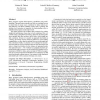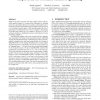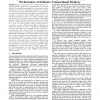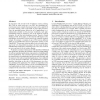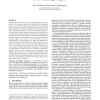132
Voted
PPOPP
2010
ACM
14 years 11 months ago
2010
ACM
Many programs exploit shared-memory parallelism using multithreading. Threaded codes typically use locks to coordinate access to shared data. In many cases, contention for locks r...
PPOPP
2010
ACM
15 years 2 months ago
2010
ACM
Helper locks allow programs with large parallel critical sections, called parallel regions, to execute more efficiently by enlisting processors that might otherwise be waiting on ...
91
Voted
PPOPP
2010
ACM
15 years 4 months ago
2010
ACM
113
Voted
PPOPP
2010
ACM
15 years 7 months ago
2010
ACM
In processors with several levels of hardware resource sharing, like CMPs in which each core is an SMT, the scheduling process becomes more complex than in processors with a singl...
121
Voted
PPOPP
2010
ACM
15 years 7 months ago
2010
ACM
This paper presents an analytical model to predict the performance of general-purpose applications on a GPU architecture. The model is designed to provide performance information ...
107
Voted
PPOPP
2010
ACM
15 years 7 months ago
2010
ACM
To fully exploit multicore processors, applications are expected to provide a large degree of thread-level parallelism. While adequate for low core counts and their typical worklo...
103
Voted
PPOPP
2010
ACM
15 years 10 months ago
2010
ACM
Irregular algorithms are organized around pointer-based data structures such as graphs and trees, and they are ubiquitous in applications. Recent work by the Galois project has pr...
113
Voted
PPOPP
2010
ACM
15 years 10 months ago
2010
ACM
This poster is a case study on the application of a novel programming model, called Concurrent Collections (CnC), to the implementation of an asynchronous-parallel algorithm for c...
105
Voted
PPOPP
2010
ACM
15 years 10 months ago
2010
ACM
Transactional Memory (TM) is considered as one of the most promising paradigms for developing concurrent applications. TM has been shown to scale well on multiple cores when the d...
101
Voted
PPOPP
2010
ACM
15 years 10 months ago
2010
ACM
We present a performance model-driven framework for automated performance tuning (autotuning) of sparse matrix-vector multiply (SpMV) on systems accelerated by graphics processing...
